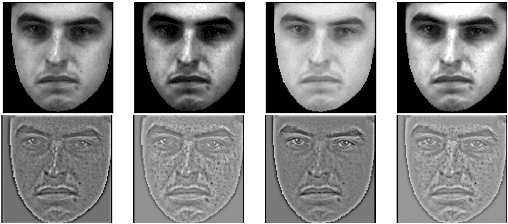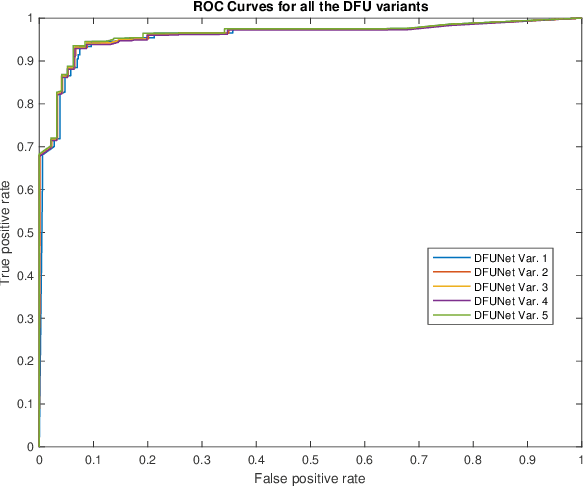Adrian K. Davison
3D-CNN for Facial Micro- and Macro-expression Spotting on Long Video Sequences using Temporal Oriented Reference Frame
Jun 10, 2021



Abstract:Facial expression spotting is the preliminary step for micro- and macro-expression analysis. The task of reliably spotting such expressions in video sequences is currently unsolved. The current best systems depend upon optical flow methods to extract regional motion features, before categorisation of that motion into a specific class of facial movement. Optical flow is susceptible to drift error, which introduces a serious problem for motions with long-term dependencies, such as high frame-rate macro-expression. We propose a purely deep learning solution which, rather than track frame differential motion, compares via a convolutional model, each frame with two temporally local reference frames. Reference frames are sampled according to calculated micro- and macro-expression durations. We show that our solution achieves state-of-the-art performance (F1-score of 0.126) in a dataset of high frame-rate (200 fps) long video sequences (SAMM-LV) and is competitive in a low frame-rate (30 fps) dataset (CAS(ME)2). In this paper, we document our deep learning model and parameters, including how we use local contrast normalisation, which we show is critical for optimal results. We surpass a limitation in existing methods, and advance the state of deep learning in the domain of facial expression spotting.
A Review on Facial Micro-Expressions Analysis: Datasets, Features and Metrics
May 07, 2018



Abstract:Facial micro-expressions are very brief, spontaneous facial expressions that appear on the face of humans when they either deliberately or unconsciously conceal an emotion. Micro-expression has shorter duration than macro-expression, which makes it more challenging for human and machine. Over the past ten years, automatic micro-expressions recognition has attracted increasing attention from researchers in psychology, computer science, security, neuroscience and other related disciplines. The aim of this paper is to provide the insights of automatic micro-expressions and recommendations for future research. There has been a lot of datasets released over the last decade that facilitated the rapid growth in this field. However, comparison across different datasets is difficult due to the inconsistency in experiment protocol, features used and evaluation methods. To address these issues, we review the datasets, features and the performance metrics deployed in the literature. Relevant challenges such as the spatial temporal settings during data collection, emotional classes versus objective classes in data labelling, face regions in data analysis, standardisation of metrics and the requirements for real-world implementation are discussed. We conclude by proposing some promising future directions to advancing micro-expressions research.
DFUNet: Convolutional Neural Networks for Diabetic Foot Ulcer Classification
Dec 10, 2017



Abstract:Globally, in 2016, one out of eleven adults suffered from Diabetes Mellitus. Diabetic Foot Ulcers (DFU) are a major complication of this disease, which if not managed properly can lead to amputation. Current clinical approaches to DFU treatment rely on patient and clinician vigilance, which has significant limitations such as the high cost involved in the diagnosis, treatment and lengthy care of the DFU. We collected an extensive dataset of foot images, which contain DFU from different patients. In this paper, we have proposed the use of traditional computer vision features for detecting foot ulcers among diabetic patients, which represent a cost-effective, remote and convenient healthcare solution. Furthermore, we used Convolutional Neural Networks (CNNs) for the first time in DFU classification. We have proposed a novel convolutional neural network architecture, DFUNet, with better feature extraction to identify the feature differences between healthy skin and the DFU. Using 10-fold cross-validation, DFUNet achieved an AUC score of 0.962. This outperformed both the machine learning and deep learning classifiers we have tested. Here we present the development of a novel and highly sensitive DFUNet for objectively detecting the presence of DFUs. This novel approach has the potential to deliver a paradigm shift in diabetic foot care.
Objective Classes for Micro-Facial Expression Recognition
Dec 03, 2017



Abstract:Micro-expressions are brief spontaneous facial expressions that appear on a face when a person conceals an emotion, making them different to normal facial expressions in subtlety and duration. Currently, emotion classes within the CASME II dataset are based on Action Units and self-reports, creating conflicts during machine learning training. We will show that classifying expressions using Action Units, instead of predicted emotion, removes the potential bias of human reporting. The proposed classes are tested using LBP-TOP, HOOF and HOG 3D feature descriptors. The experiments are evaluated on two benchmark FACS coded datasets: CASME II and SAMM. The best result achieves 86.35\% accuracy when classifying the proposed 5 classes on CASME II using HOG 3D, outperforming the result of the state-of-the-art 5-class emotional-based classification in CASME II. Results indicate that classification based on Action Units provides an objective method to improve micro-expression recognition.
Objective Micro-Facial Movement Detection Using FACS-Based Regions and Baseline Evaluation
Dec 15, 2016



Abstract:Micro-facial expressions are regarded as an important human behavioural event that can highlight emotional deception. Spotting these movements is difficult for humans and machines, however research into using computer vision to detect subtle facial expressions is growing in popularity. This paper proposes an individualised baseline micro-movement detection method using 3D Histogram of Oriented Gradients (3D HOG) temporal difference method. We define a face template consisting of 26 regions based on the Facial Action Coding System (FACS). We extract the temporal features of each region using 3D HOG. Then, we use Chi-square distance to find subtle facial motion in the local regions. Finally, an automatic peak detector is used to detect micro-movements above the newly proposed adaptive baseline threshold. The performance is validated on two FACS coded datasets: SAMM and CASME II. This objective method focuses on the movement of the 26 face regions. When comparing with the ground truth, the best result was an AUC of 0.7512 and 0.7261 on SAMM and CASME II, respectively. The results show that 3D HOG outperformed for micro-movement detection, compared to state-of-the-art feature representations: Local Binary Patterns in Three Orthogonal Planes and Histograms of Oriented Optical Flow.
 Add to Chrome
Add to Chrome Add to Firefox
Add to Firefox Add to Edge
Add to Edge